A Large-Scale Dilemma:
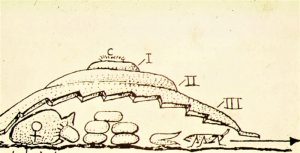
Drawing shows a shrinking female armored scale laying eggs. Waxy covers of each of the 3-instars are pushed above the other. Crawlers emerge from the female cover through the one-way flap. (Drawing Credit: John Davidson, Univ. of MD)
Undoubtedly many arborists, landscapers, nurserymen, and golf course superintendents would agree that effectively controlling scale insects is one of the more frustrating pest management challenges encountered. Of the half-dozen major families of scale insects common in the urban landscape, the armored scales are the most troublesome. With their protective waxy covering, armored scales are considerably less susceptible to various insecticide spray treatments.

Reddish colored crawlers of Pine Needle Scales emerging out from under female waxy covers. (Photo Credit: Ohio State Coop. Ext.)
Historically, many pesticide spray applicators fail to achieve satisfactory controls because they do not have the time or inclination to apply sprays during the scale crawler emergence periods. To complicate matters, the crawler periods for the various armored scale species are quite variable. Furthermore, the improper timing of long residual pyrethroid insecticides can virtually eliminate important parasitoid bio-control activity and hence, often encourage scale infestations. The intention of this blog is to stress the importance of properly timed treatments to achieve better management of scale insects. This is especially true when attempting to control armored scales.
Despite the complications stated above, fortunately some relatively newer insecticides have given improved abilities for scale controls. These newer materials & the life cycles of 5-armored scale species will be covered in this blog. The scales covered include: 1-Euonymus scale; 2-Cryptomeria scale; 3-Japanese maple scale; 4-White Prunicola scale; & 5-Juniper scale.
Newer generation of insecticides providing better armored scale controls: During the past 15 years, landscape managers have had an increasing number of pest management materials that have improved their success with controlling armored scales. University trials against armored scales using some of the neonicotinoid’s such as Safari (dinotefuran), TriStar (acetamiprid), & Flagship (thiamethoxam) have all shown some excellent results. When the best control windows for crawler activity is missed, then these additional products can be useful tools. Distance (pyriproxyfen) & Talus (buprofezin) are both insect growth regulators. Distance is a juvenile hormone mimic & Talus is a chitin synthesis inhibitor. Both materials will give best efficacy against crawler emergence stages.

Yellow colored Euonymus Scale crawlers emerging. These crawlers moved to leaves from branch stems where the female mostly feed. (Photo Credit: Steven K. Rettke, Rutgers Coop. Ext.)
Euonymus Scale (Unaspis euonymi) (533-820 GDD 1st generation crawlers): The light-yellow crawlers are active during the early weeks of June or when the Kousa Dogwood is in bloom (i.e., within the more southern counties of NJ, crawlers have been active for at least a week). Variegated evergreen euonymus plants are especially vulnerable to this scale. This armored scale has sexual dimorphism since the males are white, thin & elongated while the females are dark-brown, oyster-shell shaped & larger. Males feed primarily on leaves & the females will more commonly be found feeding on branches.
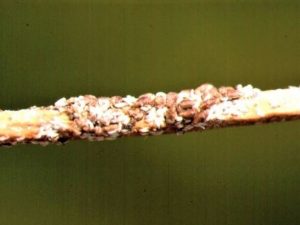
Euonymus Scales have sexual dimorphism with females being dark gray & oyster-shell shaped while males are white & narrowly elongated. (Photo Credit: Steven K. Rettke, Rutgers Coop. Ext.)
Check plants now for crawlers in the southern half of NJ! Monitor before treating by using double-sided tape or sticky traps. Use a hand lens to see the yellow/orange tiny crawlers. Multiple sprays may be required if using horticultural oil since crawler’s hatch over a 2–3-week period. This scale feeds within plant cells & the mostly males feeding on leaves will create distinctive symptoms having off-colored yellow spots. If populations are allowed to build-up, then defoliation will result, and the plant will be weakened. With higher infestations, Euonymus scales will frequently kill most species of evergreen Euonymus. There will be a 2nd generation of crawlers emerging in August-September.
Most armored scale species with broadleaf hosts will feed either on bark or leaf tissues, but usually not both (Euonymus scales are a notable exception). The crawlers have only 24 to 48 hours after hatching before they must insert their mouthparts into plant cells and begin feeding. Once armored scale crawlers settle, they do not move again for the remainder of their lives (winged adult male scales do change positions but cannot feed and only live for 24 hours).
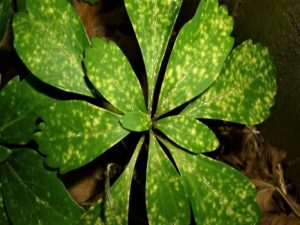
Feeding symptoms from male Euonymus Scales feeding on Pachysandra leaves. (Photo Credit: Steven K. Rettke, Rutgers Coop. Ext.)
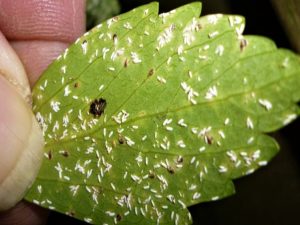
Turn over on the undersides of the Pachysandra leaf & signs from mostly males & a few females are found feeding. (Photo Credit: Steven K. Rettke, Rutgers Coop. Ext.)
A horticultural oil plus Orthene combination has shown to provide good control management after crawlers settle (before they turn white/gray). The Orthene will suppress the white males feeding on the leaves, while the oil reduces the brown females present on the stems. The systemic insecticide Safari (dinotefuran) can also be successful. The reduced risk neonicotinoid, TriStar (acetamiprid) will also provide results against this scale insect. Euonymus kiautschovica has resistance against euonymus scale & should be used as a replacement where possible.
Cryptomeria Scale (Aspidiotus cryptomeriae) (600-800 GDD = 1st generation crawler emergence): Beware of the Cryptomeria Scale which hides beneath a transparent cover. The Cryptomeria scale is found on true firs, hemlocks & pine. It is commonly found at Christmas tree farms where the damage potential is particularly high. Curiously, it will rarely be found feeding on Cryptomeria.
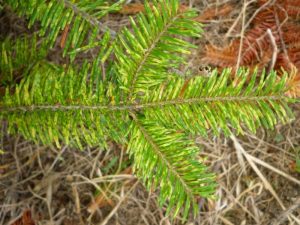
Symptoms on Frasier-fir by Cryptomeria Scale at undersides of needles. (Photo Credit: Steven K. Rettke, Rutgers Coop. Ext.)
Observing Symptoms & Signs: Cryptomeria scales can quickly overwhelm true firs in landscapes, nurseries, or Christmas tree farms. Christmas tree farms growing Fraser, Canaan, and balsam firs need to understand the high damage potential from this scale & be especially vigilant to take the time to monitor for its presence. When monitoring, inspect the undersides of the needles on the lower, inner branches. The scale has the look of a “fried egg” & has a highly flattened appearance with cast skins in the middle. The thin waxy cover of younger scales is almost transparent & do not become opaquer until they reach maturity. When observing the scales on leaf undersides, it is often possible to still see the rows of white stomata on the needle through the nearly transparent waxy covers. When populations are high, the upper needle symptoms will have a mottling or chlorotic banding appearance. These scales feed within plant cells & remove green chlorophyll. These symptoms will usually be most obvious & easily observed at the lower branches.
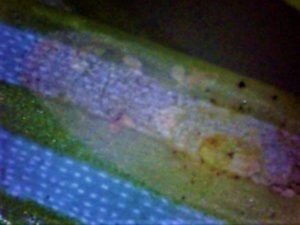
With younger instars the Cryptomeria waxy cover is virtually transparent, as needle stomates are clearly visible. (Photo Credit: Steven K. Rettke, Rutgers Coop. Ext.)
Crawler Emergence: Like many other armored scale species, the Cryptomeria scale has more than one generation of crawlers during the growing season. In New Jersey, this scale has two crawler generations per year & they generally begin in June & then again in August. First generation crawlers begin to emerge at 600-800 GDD’s. Second generation crawlers begin to emerge at 1750-2130 GDD’s. Crawlers are lemon yellow in color & because of the color contrast can typically be easy to observe on needles, even without a hand-lens. Unfortunately, the crawler emergence periods of both generations of Cryptomeria scale are not restricted to only a week or two. Their more prolonged crawler periods can extend for 4 weeks or even longer, although a large percentage of crawlers will occur during the first 2 weeks after emergence begins.
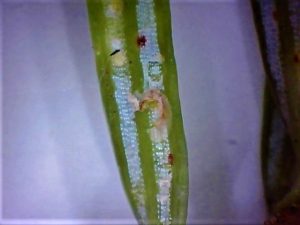
Predators such as lady beetles will create large rough tears in the scale waxy cover. (Photo Credit: Rutgers Cooperative Ext.)
Control Strategies: When applying control materials with short residuals (e.g., horticultural oils), the use of multiple applications will probably be required to achieve a more complete crawler suppression. If a single application is desired, then oils plus synthetic pyrethroids can provide a 3-week residual. Examine infested trees closely to determine if significant predators or parasitoids are presently active. When numerous, these beneficials can be extremely valuable to help with suppression. Therefore, the use of horticultural oil applications alone will help conserve the beneficials & still control crawlers when coverage is adequate. The use of some of the neonicotinoid insecticides (e.g., Merit) will not achieve satisfactorily controls (maybe only 30-40% efficacy). Alternatively, the usage of dinotefuran (Safari) as a soil drench or bark spray has been shown to give excellent results against armored scales, with some studies showing 90% efficacy. The extremely high-water solubility of Safari allows this material to penetrate the plant cells where the scales are feeding.
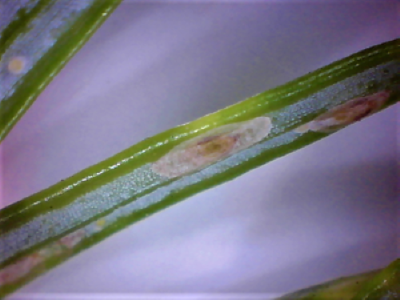
As the Cryptomeria Scale matures, the waxy cover becomes more opaque. (Photo Credit: Steven K. Rettke, Rutgers Coop. Ext.)
Japanese Maple Scale (Lopholeucaspis japonica) (800- 1200 GDD = 1st generation crawler emergence): The 1st generation crawlers of the Japanese maple scale will continue to emerge in June & extend for 8-weeks after initial hatch. Therefore, multiple spray treatments will be required when using short residual materials such as horticultural oils. This armored scale feeds within individual mesophyll cells on woody branches and typically cause more damage than will foliage feeders. They are more likely to generate individual branch dieback and can even kill trees. Since armored scales do not feed in vascular tissues they will not secrete honeydew and do not promote the corresponding black sooty mold. Unlike soft scale species, armored scales typically are a highly persistent pest on woody plants and can continue for many years once established.

Large population of Japanese Maple Scales observed on main stem of infested tree. This scale will only feed on bark. (Photo Credit: Steven K. Rettke, Rutgers Coop. Ext.)
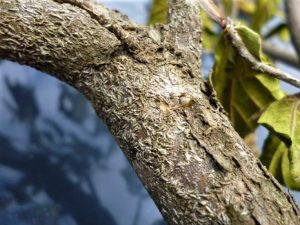
With extreme infestations of Japanese Maple Scales the death of branches can occur. (Photo Credit: Steven K. Rettke, Rutgers Coop. Ext.)
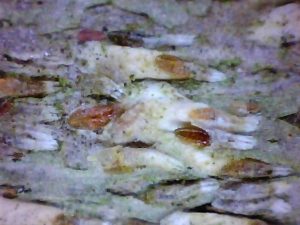
When the white waxy cover of the Japanese Maple Scale is removed, the brownish-purple scale body is exposed. (Photo Credit: Steven K. Rettke, Rutgers Coop. Ext.)
Both male & female Japanese maple scales have a similar white, elongated waxy cover, but with the females being larger. This is the only common armored scale species having these shape appearances that exclusively feeds on bark in our region. Also, the removal of the cover will show the scale body to have a deep purple coloration. All these characteristics are diagnostic for the ID of the Japanese maple scale. Although the host range is large, within nurseries they have most often been seen infesting on maples. Other potential hosts include firethorn, serviceberry, lilac, cotoneaster, Prunus plus others.
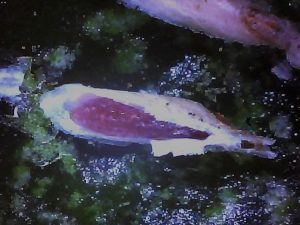
White waxy cover is scraped-off & turned over to expose the jelly-like “blob” of the Japanese Maple Scale. (Photo Credit: Steven K. Rettke, Rutgers Coop. Ext.)
The armored scales protective covering is produced by waxy filaments and glue exuded through ducts and pores on the body. Without the protective cover the delicate “jelly-like” body of an armored scale would be extremely susceptible to desiccation and predation. This protective covering gives armored scales higher natural survival rates throughout the various life stages and allows for more conservative egg laying. As a result, the average armored scale species only produces between 10 to 80 eggs per female. The survival rates of soft scale species are much lower; therefore, many will lay as many as 1000 to 2000 eggs per female.
White Prunicola Scale (707-1151 GDD = crawler emergence): The light-red crawlers will hatch and become active in many areas of the state during the next two weeks. This is the 2nd of three generations. It attacks plants in the genus Prunus, especially flowering cherry. Is also found on lilac, Ilex, and privet. On the flowering cherry in the landscape, it will often build-up with extreme infestations on the stem & major branches. Within container nurseries this scale has been seen with significant numbers at the base of stems on blue holly plants. The white prunicola scale is another armored species that is particularly difficult to control because the crawler generations can continue to emerge over prolonged periods of time throughout the season. The second and third generations occur during the early and late summer periods. Soaps and oils (1%), targeting the branches and trunks will control crawlers when seen. Plan a dormant oil application for late winter next year to target fertilized females overwintering on bark of twigs & branches.
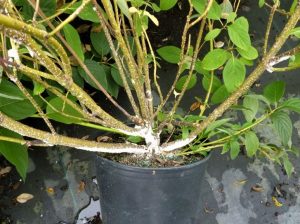
With nursery container plants, the White Prunicola Scale on blue hollies is typically found infesting the lower branch stems near the base of the plant. (Photo Credit: Steven K. Rettke, Rutgers Coop. Ext.)
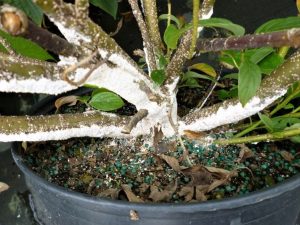
Close-up of the lower stems of a blue holly with an extreme infestation of White Prunicola Scale. Male scale covers have completely obscured the females scales. (Photo Credit: Steven K. Rettke, Rutgers Coop. Ext.)
The white prunicola & white peach scales are indistinguishable from one another without a compound microscope. The white prunicola species is more tolerant of cold winter temperatures & will usually be found north of Virginia. The white peach scale is typically found in Virginia & further south.
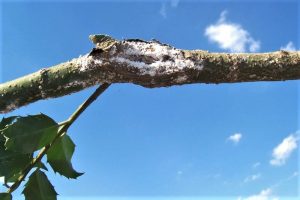
Holly branch infested with White Prunicola Scales. Male scale cover waxy filaments are most apparent. Armored scales are capable of killing infested branches. (Photo Credit: Steven K. Rettke, Rutgers Coop. Ext.)
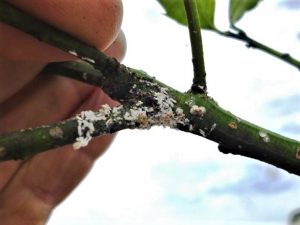
Males scales have a white, elongated shape & the female scales are a circular shape with a yellow cast skin in the center. (Photo Credit: Steven K. Rettke, Rutgers Coop. Ext.)
When physically removed from bark or leaf tissue all scale species will leave a white ring of their outer margins. These white rings are waxy adhesives used to closely attach themselves to the plant host. This is an important sign that can be used to avoid making unnecessary treatments against non-scale look-a-likes sometimes seen in the landscape.
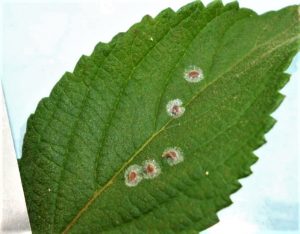
Are these scales that require treatment? No! They are plant seeds that exuded oils, that turned white when dried & stuck to leaf. (Photo Credit: Steven K. Rettke, Rutgers Coop. Ext.)
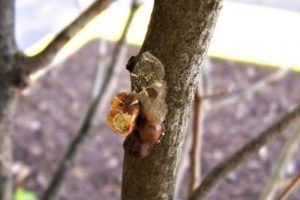
When any type of scale insect cover is removed from the surface of a plant, it will leave behind a white-ring. If what was removed from the plant does not leave a white-ring, then it is not a scale. (Photo Credit: Steven K. Rettke, Rutgers Coop. Ext.)
Juniper Scale (Carulaspis juniperi) (707-1260 GDD = crawler emergence): This imported armored scale insect is found on the foliage and twigs of primarily juniper & other conifers such as false-cypress, Leyland cypress & occasionally arborvitae. The female covers are circular and white (1/16 inch in diameter). The male covers are white and elongated and are even smaller in size. Yellowish cast skins are attached to the surface of the waxy covering of both sexes. Adult females overwinter on the foliage and there is only one generation each year.
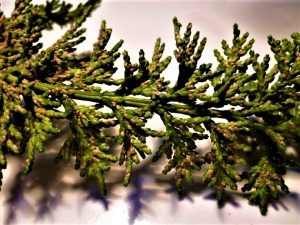
Foliage of a false-cypress branch heavily infested with Juniper Scales. (Photo Credit: Steven K. Rettke, Rutgers Coop. Ext.)
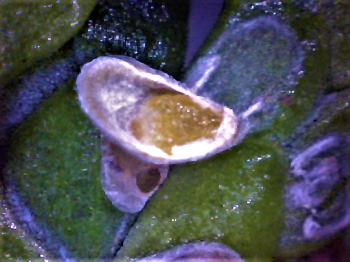
Juniper Scale removed from leaf to expose yellow scale body. Notice white-ring present on leaf at upper right. (Photo Credit: Steven K. Rettke, Rutgers Coop. Ext.)
With light infestations there are often no apparent symptoms. Significant populations of 10 or more scales per ½ inch of twig can result in yellowed foliage and needle drop. Populations that remain unabated will result in dieback and an unattractive plant. Scales usually build-up first on the south side of shrubs or on the side against buildings. With average seasonal temperatures, crawlers start hatching by mid-June and can continue well into July.
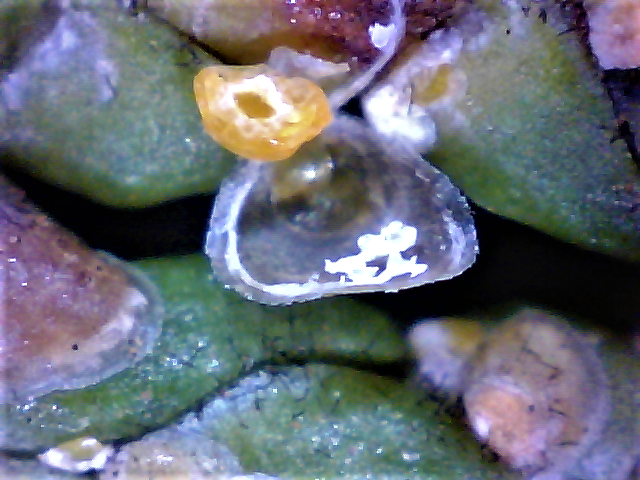
The waxy cover is not attached to the actual armored scale insect & can be removed. Unlike the leathery exoskeleton of soft scales that cannot be removed. (Photo Credit: Steven K. Rettke, rutgers Coop. Ext.)
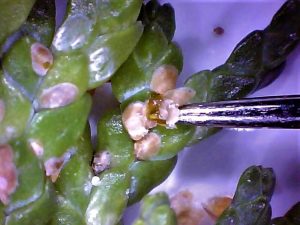
Test for scale viability with a sharp pin to determine if body fluids emerge. If no fluids are present, then only the cover remains or the scale body is desiccated & dead.(Photo Credit: Steven K. Rettke, Rutgers Coop. Ext.)
Controls may not be required if many beneficials are present. Monitor especially for dusty wing predators and for parasitoid emergence holes in scale covers. Predators will create large, rough tears within the covers. Dormant oil sprays can be used, and summer oils or insecticidal soaps can be targeted against the crawlers. A late summer systemic insecticide such as acephate (Orthene) can be applied if the crawler stage is missed. When predators are observed in large numbers avoid using materials such as pyrethroids or Orthene to preserve them. The use of the IGR’s Talus & Distance plus horticultural oil are good alternative choices when attempting to conserve beneficials. Talus & oil mixtures have shown to clog-up spray nozzles.
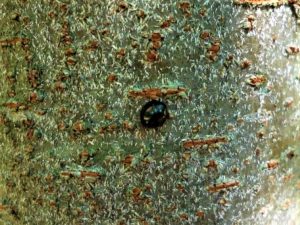
Twice-stabbed lady beetle adult is wandering through a prey-rich field of Japanese Maple Scales. (Photo Credit: Steven K. Rettke, Rutgers Coop. Ext.)
Predator & Parasitoid Wasp Controls: It is generally understood that wasp parasitoids can provide effective biological controls for reducing scale pest populations. Research has shown this to be particularly true for the suppression of armored scale insects. The larvae of parasitoids feed on the adult scales beneath their protective waxy cover. It is impractical in the field to monitor for the level of suppression by turning over the covers and examining individual insects with a hand-lens. A more effective method is to observe characteristic circular holes in the scale covers that are created by emerging adult wasps. With armored scales there is often only one exit hole per scale cover. If irregular or jagged holes are noticed in the covers, then lady beetle predators were probably present.
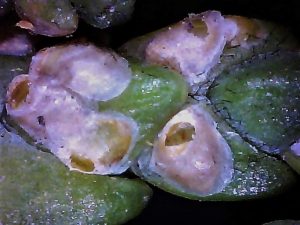
Most of the Juniper Scales have a single parasitoid exit hole in their waxy covers. These scales were successfully controlled without the use of insecticides. (Photo Credit: Steven K. Rettke, Rutgers Coop. Ext.)
When inspecting scale infestations, if many covers are seen having circular exit holes, then it is recommended that insecticide sprays not be made. The conservative use of control sprays is especially suggested if scale population densities are low, and no plant symptoms are evident. Numerous studies have indicated that the random or non-timed spraying of various insecticides against armored scale populations in the field is often counterproductive. Many times, scale populations can be successfully suppressed by wasp parasitoids, but this ability is compromised when sprays are applied. All too often, improperly applied insecticides destroy beneficial parasitoids, have little impact on the scale pest populations, and may cause scale populations to increase.

